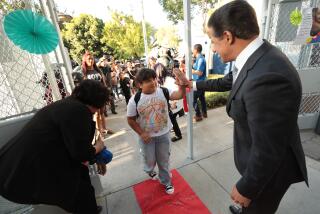District’s Standard Test Gets High Marks
- Share via
SAN JUAN CAPISTRANO — Imagine a standardized test that covers what’s actually taught in a classroom, poses questions for all students that are neither too hard nor too easy, and tells parents and teachers exactly how much each child learned over the school year.
Most California teachers would tell you to dream on. But not in this fast-growing corner of southern Orange County.
Capistrano Unified School District is one of only four districts--and the only one in Southern California--that have won state approval in the past two years for their own, self-designed standardized tests.
But Gov. Pete Wilson’s call this week for a new statewide basic skills test has left a crucial question hanging over Capistrano: Which test?
Wilson proposes that the state buy an “off-the-shelf” test from a major publishing company to evaluate the state’s massive class-shrinking initiative. If his plan goes forth, Capistrano students would have to take that test.
The district could still do its own cutting-edge testing in addition to the statewide exam, but the state no longer would pay for it.
What Capistrano administrators hope is that they might persuade the state Legislature and education leadership to consider their approach as a model instead.
“If Sacramento has an open process, we think we can make a compelling case that the state should use our program,” said James A. Fleming, Capistrano superintendent. But he added: “California is such a diverse state, that I wonder if any single test could satisfy all political constituencies.”
Oddly enough, what first spurred Capistrano to rethink testing was the celebrated collapse of the California Learning Assessment System in 1994. That statewide test was riddled with logistic and technical glitches and drew fire for some of its open-ended questions.
Since then, districts have been left to their own devices. Most have chosen tests from major companies such as CTB/McGraw-Hill and Riverside Publishing Co. Los Angeles Unified, the nation’s second-largest district with 667,000 students, in the past year bought the Stanford Achievement Test from Harcourt Brace.
Capistrano, a 37,000-student district stretching from San Clemente to Mission Viejo, developed its own test in 1994-95 with help from a nonprofit educational cooperative based in Oregon, the Northwest Evaluation Assn.
Clusters of teachers and administrators choose test items from the organization’s databank, tailoring the format to their needs. For instance, math teacher Pat Schubert of Capistrano Valley High said her colleagues sought emphasis on probability and statistics.
“That’s one of the beauties of it,” Schubert said. “We can make sure the questions are modern, up to date, and reflect our curriculum.”
“Capistrano did it right,” said Peter Boothroyd, an assistant superintendent of Brea Olinda Unified School District, “because they created their curriculum and their testing instrument at the same time. There is a definite alignment between what they’re teaching and what they’re testing. So you can measure a student’s growth.”
Even so, Boothroyd said, the approach is too costly for a small district like his, which instead is trying out standardized exams from three major publishers.
Many Capistrano teachers echo Boothroyd’s praise, including veterans who have seen testing theories come and go.
Lynn Lindsey, a fifth-grade teacher here at Del Obispo Elementary, said she’s getting more feedback than she has had in 33 years of teaching. Best of all, she said, the results square with her own instincts of how children are doing.
“What’s exciting is we can see how our programs work for an individual child,” Lindsey said. “It has implications for what lessons I’m going to give tomorrow to the entire direction the school is going to go.”
On a recent day, Lindsey gave a multiple-choice test covering spelling, punctuation and sentence structure, among other skills. Similar tests on other days covered mathematics and reading. None of that is unusual.
What sets Capistrano apart: Lindsey handed out five separate exams to her students, each calibrated at a different degree of difficulty. In theory, every exam pushed every student without overtaxing any of them.
That departs from traditional methods. Backers of the so-called level tests say they reduce student frustration and boredom--the better to assess what each student can do.
Later, computers at district headquarters will churn out a skills profile of each student, showing parents and teachers how that student is achieving over time. The procedure is repeated twice a year, in fall and spring, for grades two through 10.
Lindsey discussed fall results with parents in October. She said the test helped her find students lagging or ahead of the average. Nine, for example, needed remedial help in math. The spring test, given in April and May, will show how much progress was made.
For those who want rankings, Capistrano officials also give a percentile score for students and schools, drawing from a recent 200,000-student study of members of the Oregon cooperative, including the well-regarded Portland schools.
The other California districts with self-designed tests also use the Oregon group’s model. They are Sacramento City Unified, San Lorenzo Valley Unified and Alameda Unified, all of which now face the same dilemma as Capistrano. Outside the state, the 20-year-old cooperative’s membership includes dozens of districts, mainly in the West.
That is a smaller pool than those used by the major test companies. But Capistrano has other ways to measure itself against other districts. It usually does well on Advanced Placement exams and the Scholastic Assessment Test.
One enthusiastic parent, Suzy Elliott of Rancho Santa Margarita, said last fall’s test helped confirm that her son Sam, in fourth grade, had mastered his multiplication tables after a summer review.
“It’s a direct follow-through,” Elliott said. “You can see whether your reading curriculum is working, or your math.”
In the wake of Wilson’s announcement Tuesday, major test companies were gearing up for a test-choosing derby with millions of dollars at stake. In the first year, Wilson’s proposal for testing from grades two through 11 would cost $83 million. The State Board of Education would choose the test.
CTB/McGraw-Hill, which has the largest share of the California testing market, is touting a new test called TerraNova, used in San Diego and several states nationwide. The company says educators can customize the exam.
Capistrano officials say their new testing system has cost about $160,000 to develop, of which $120,000 has been repaid by the state through a $5-per-student subsidy. That subsidy would end under Wilson’s plan.
Having sunk so much time and money into their tests, officials here now must decide what to do if the state forces them to give a commercial test every spring. Fleming said he would favor giving the district test in any event, perhaps just in the fall. “If what the state wants and what we want are two different things, then we need to sit down and talk,” said Peter Espinosa, president of the Capistrano board of trustees. “It’s too important an issue to just buy into [a new test] unless there’s some meaningful dialogue.”
More to Read
Sign up for Essential California
The most important California stories and recommendations in your inbox every morning.
You may occasionally receive promotional content from the Los Angeles Times.










